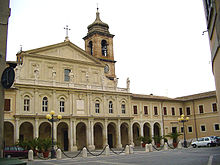Bishop of Terni-Narni-Amelia
|
Diocese of Terni-Narni-Amelia Dioecesis Interamnensis-Narniensis-Amerina |
|
|---|---|

Terni Cathedral
|
|
| Location | |
| Country | Italy |
| Ecclesiastical province | Immediately subject to the Holy See |
| Statistics | |
| Area | 871 km2 (336 sq mi) |
| Population - Total - Catholics |
(as of 2010) 157,900 156,100 (98.9%) |
| Parishes | 82 |
| Information | |
| Denomination | Catholic Church |
| Rite | Roman Rite |
| Established | 2nd century |
| Cathedral | Cattedrale di S. Maria Assunta (Terni) |
| Co-cathedral | Concattedrale di S. Giovenale (Narni) Concattedrale di S. Firmina (Amelia) |
| Current leadership | |
| Pope | Francis |
| Bishop | Bishop-elect Giuseppe Piemontese |
| Map | |
 |
|
| Website | |
| www.diocesi.terni.it | |
The diocese of Terni-Narni-Amelia (Latin: Dioecesis Interamnensis-Narniensis-Amerina) is a Roman Catholic ecclesiastical territory in Umbria, central Italy. It was created in 1983, when the Diocese of Amelia was united to the Diocese of Terni and Narni. The latter had been in turn created in 1907, when the Diocese of Narni was united to the historical Diocese of Terni. The diocese is exempt, i.e. immediately subject to the Holy See, not part of any ecclesiastic province.
Terni is the ancient Interamna Nahars of the Umbrians, and the cathedral, and other churches, are built on the sites of pagan temples. After the Lombard invasion, Terni belonged to the Duchy of Spoleto, and with the latter, came into the Pontifical States. It was at Terni that Pope Zacharias entered into the agreement with King Luitprand for the restitution of the cities of Bieda, Orte, Bomarzo, and Amelia to the Duchy of Rome.
It is believed that the gospel was preached at Terni by Saint Peregrinus, about the middle of the second century. Saint Valentinus has a basilica outside the city. There were other martyrs from this city, among them Saints Proculus, Ephebus, Apollonius, and the holy virgin Agape.
In the time of Totila, the Bishop of Terni, Saint Proculus, was killed at Bologna, and Saint Domnina and ten nuns, her companions, were put to death at Terni itself. After the eighth century Terni was without a bishop until 1217, in which year the diocese was re-established.
...
Wikipedia
